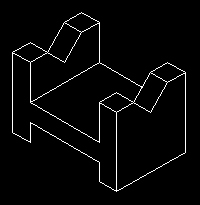
Gasket
How Many Views Do You Need?
[CF, CA, COM]
Most products require three views to describe them fully. The decision as to the number of views involves a close study of the product. Use enough views to describe all the features and no more. Providing too much information can become confusing to the reader of the drawing.
One View Drawings
There are many products that can be described with one view and a note. A gasket or other thin, flat product can have a note giving the thickness, thus eliminating the need for all views except the front.

Gasket
Two View Drawings
Products that are symmetrical, conical, or pyramidal in shape can usually be described in two views.
Two View Drawing of a Cap

Three View Drawings
Most Products require three-view drawings.

While the front, top, and right side views are most frequently used, any other regular orthographic views could be used instead. In the figure below, the front, right and top views are used.

More Than Three Views
The designer can use any or all of the six normal orthographic views. The views used must present information that is not clearly shown by the other views. The object below (left) has hidden detail not seen from the front, top, or right. As a result, in addition to the traditional front, top and right views, a bottom view is needed to show the recesses.
 Pictorial View of Object |
 Object rotated 180 degrees |
4 View Orthographic Projection
